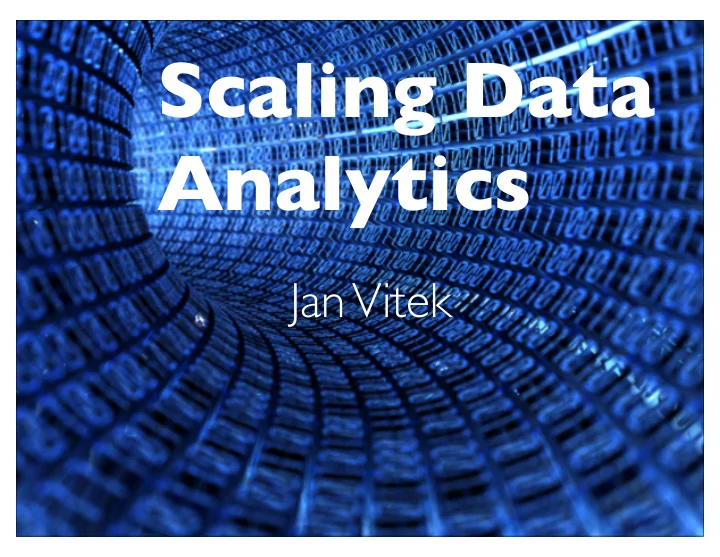

Scaling Data Analytics Jan Vitek
Challenges • How do we program big data? • What are the tools? • What are the abstractions? • How do we debug, visualize, tune big data?
Some big data infrastructures Hadoop MapReduce X10 RHIPE Pig Hive Flume/Java
4 Myths • Big data is big. • Big data is speed. • Big data is storage. • Big data is hard.
Requirements • Scale up vs. Scale down • Rapid feedback, interaction with data, partial results • Familiarity, ease of development • Ease of deployment • Portability and heterogeneity • Robustness • Efficiency
A tale of two communities • Computer Scientists : Fixed programs, transient data. i.e. there will always be another input • Data Scientists : Fixed data, transient programs. i.e. there will always be another query. • This dichotomy leads to a different world view in terms of design. In CS, languages/tools are built around static code abstractions. In DS, everything is dynamic and lightweight.
High-level dynamic languages • Programming is simplified by the language virtual machine • memory management • threading • platform heterogeneity • At a cost • Performance • Footprint
ReactoR… • … create an open source platform for data analytics at scale • … built in collaboration by Purdue, INRIA, Stanford & Oracle
ReactoR Overview } DS in R R+BigVector } CS in R O2 FastR Java Substrate Hotspot LLVM Native Libraries OracleDB NFS Hadoop Web } } } Oracle Purdue INRIA
Why R? … language for data analysis and graphics … open source … books, conferences, user groups … 4K+ packages … 3mio users
Scripting data read data into variables make plots compute summaries more intricate modeling develop simple functions to automate analysis …
Why Java? … portable … supports heterogenous platforms … concurrent … robust and stable … fast enough … books, conferences, user groups … thousands of packages … millions of developers
Scaling up… Current limitations of R on a single node: • Speed • Memory footprint • Limited support for concurrency
Python R 500 50 10 5 1 S − 1 S − 2 S − 3 S − 4 S − 5 S − 6 S − 7 S − 8 S − 9 S − 10 S − 11 S − 12 Avg Performance relative to C Shootout
1.0 0.9 0.8 0.7 mm alloc.cons alloc.list 0.6 alloc.vector duplicate 0.5 lookup match external 0.4 builtin arith 0.3 special 0.2 Time breakdown 0.1 0.0
10000 1000 100 10 1 S − 1 S − 2 S − 3 S − 4 S − 5 S − 6 S − 7 S − 8 S − 9 S − 10 S − 11 S − 12 C Heap Memory R User data Shootout R internal
FastR status FastR is a new R virtual machine written in Java • Aims for compatibility & completeness • Abstract syntax tree interpreter (80% complete for core language) • LLVM JIT compiler (30% complete) • Substrate VM (10% complete)
Relative speedup (larger is better) 0 1 2 3 4 5 spectralnorm fasta Speedup of FASTR over GNU − R nbody fannkuch binarytrees mandelbrot fastaredux pidigits regexdna
O2 O2 is self-organizing computational cloud for analytics. • Written in Java for portability and ease of deployment • Provides BigVectors as arraylets that can be distributed, moved, and swapped to disk • Provides a Distributed Fork/Join framework for both local and remote concurrent computation
Distributed F/J for (int i : ntrees) trees[i] = new Tree(_data,maxDepth,...); DRemoteTask.invokeAll(trees); print("Trees done in "+ timer);
Single node Random Forest (O2 v Fortran/R) Tree build time data rows size F J avg tree sz iris 8KB .15K 8 2ms 8ms chess 196K 3.7MB 8 140ms 200ms stego 7.5K 11MB 557 440ms 2.4s kaggle/cs 100K 4.3MB 5321 420ms 1s kaggle/as 580K 1.7GB 45894 -- 25s covtype 8.7M 72MB 95393 -- 3s Distributed random forest in 3K lines of Java on O2
Conclusions • Scaling data analytics is about making it easier to turn idea into software • It requires an integrated infrastructure that leverage advances in programming languages and compilers technology with a deep understanding of the domain. • Interactive exploration and time to solution are the most important factors
Recommend
More recommend